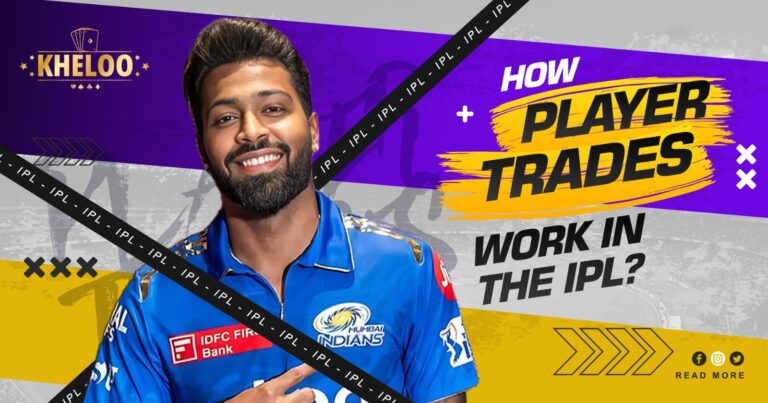What exactly is a player trade in the IPL, and when does this shuffle happen? A player trade occurs when a player shifts from the IPL team that initially acquired them to another franchise during the designated trading window. This trade can take the form of a straightforward cash exchange or a swap involving players. As per IPL regulations, the player-trading window kicks off approximately a month following the conclusion of a season. It keeps its doors open until a mere week before the auction day. And then, it extends its reach again, stretching up to a month before the commencement of the upcoming season. So, as of now, the current trading window remains ajar until December 12, aligned with the auction set for December 19. Post this auction, the window reopens on December 20, persisting until a month prior to the launch of the 2024 IPL season.
The Evolution of Trades in IPL
Back in 2009, something new rocked the world of IPL cricket – trading players. It was a big change, shaking up how teams operated. One moment that stood out was when Mumbai Indians did something unexpected. They swapped Ashish Nehra for Shikhar Dhawan from Delhi Daredevils, now known as Delhi Capitals.
Cracking the Code: What’s a One-Way Trade?
A one-way trade occurs when a player transitions from Team A to Team B through a straightforward, cash-based transaction. In this scenario, Team B compensates Team A with an amount equivalent to the player’s value at the auction. Take the case of Hardik Pandya, where the Gujarat Titans’ payment during his acquisition before the 2022 player auction serves as the benchmark.
Ever wondered about a two-way trade in the IPL? It’s a savvy manoeuvre involving a direct player swap between franchises. Picture this: one team offers compensation for the disparity in the players’ worth, sealing the deal.
Do players hold sway in these swaps? Absolutely. A player’s consent stands as the linchpin before any trade materializes. Take the case of Hardik Pandya’s return to Mumbai Indians. Insights from ESPNcricinfo reveal Mumbai Indians’ post-2023 IPL deliberations with Titans, contemplating the nature of the trade – an all-cash transaction or a player swap. Vikram Solanki, Titans’ director of cricket, disclosed that Hardik expressed a keen desire to reunite with Mumbai. Eventually, a hefty sum of INR 15 crore exchanged hands in an all-cash trade, sealing Hardik’s return.
Brushing Against Rules: Ravindra Jadeja’s Saga
But haven’t there been instances where players skirted the rules? In 2010, the IPL barred Ravindra Jadeja for an entire season. His transgression? Skipping the renewal contract signing with Rajasthan Royals and attempting negotiations with Mumbai. The IPL flagged this move as a breach of player trading and operational regulations.
What if a player yearns for a change, but their franchise clings on? Here, the franchise holds the cards, wielding the ultimate authority over whether the player stays or departs.
Also Read: Who is the King of IPL in 2024?
Deciphering Transfer Fees: Who Decides and Limits
Now, let’s demystify transfer fees. These amounts, paid during a trade, stand apart from a player’s designated price. Reflecting on Hardik’s transfer, Mumbai disbursed an undisclosed transfer fee to Titans, strategically avoiding any dent in their auction purse. Crucially, the transfer fee is a mutually settled sum between the involved franchises, remaining hidden from the public eye. While there exists no hard limit for these fees, only the IPL and the trading franchises are privy to this pivotal detail.
Ever wondered if players get a slice of the transfer fee pie? Well, the contract might dictate that a player could potentially claim up to 50% of the transfer fee. But, here’s the kicker – it all hinges on the agreement struck between the player and the selling franchise. No guarantees exist regarding the player’s entitlement to a share of this fee.

Transfer Fee’s Impact on Auction Purse: A Clear Divide
Curious about how the transfer fee jostles the auction purse? Here’s the lowdown: It doesn’t. Take the case of Hardik Pandya. Mumbai’s auction purse takes a hit of just INR 15 crore (Hardik’s price), while Titans’ purse swells by the same amount. The transfer fee operates independently from the auction purse, maintaining a distinct financial realm.
Do richer franchises hold an edge by splurging on hefty transfer fees to poach players? Well, in a way, yes. Deep-pocketed franchises can dangle amounts beyond their auction purse constraints to acquire desired players. But, and here’s the catch, no trade sails through sans the consent of the player’s current team.




Comments are closed.